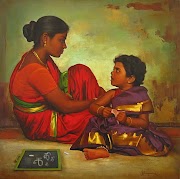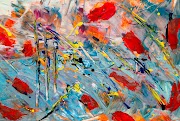''Del Campo's vibrant, uplifting, energetic, expressive paintings are pure observations of people and the world they live in whether walking in the street or relaxing on a warm Mediterranean beach.
His confident brush strokes bring his canvases to life with light and colour jumping off the surface to capture the viewer's attention. Del Campo observes people browsing through shops or deep in conversation, his paintings are informative and narrative with the freshness and clarity of the southern sun.
Del Campo's work is popular and widely collected, his paintings have been placed in both corporate and private environments.''
His confident brush strokes bring his canvases to life with light and colour jumping off the surface to capture the viewer's attention. Del Campo observes people browsing through shops or deep in conversation, his paintings are informative and narrative with the freshness and clarity of the southern sun.
Del Campo's work is popular and widely collected, his paintings have been placed in both corporate and private environments.''
What Del Campo shows us is a new urban middle class of attractive young people. He shows them in city settings, and also occasionally at the beach. Their clothes are much lighter and simpler than those that would have been worn in the past. They show more bare flesh, even when they are not at the beach. Their physical attitudes are suppler and freer, and indicate the confidence they have in their own bodies. There are occasional references to characteristically modern amusements, such as skateboarding, and to contemporary technological gadgets, such as mobile phones.
It is clear that the painter is particularly attracted to young women, but he treats them in a very different way from the way in which Degas treats his ballet dancers, or his young women washing themselves. With Degas one is always aware of both the intellectual and social gulf between the painter and his subjects. He once referred to the models who posed for his studies of women bathing as being like ‘cats, licking themselves’- a remark that implies that they belonged to a different species from that of the artist himself. With del Campo there are no such barriers – the women he portrays are shown as his equals, or, as one might say in contemporary shorthand, as being ‘part of the same scene’. One telling detail, in some of the paintings, is the presence of books. In Pareja de espaldas, two books spill out of the rucksack in the foreground. In Chicas sentadas con un libro, a book is the object of a discussion between two girls. The implication, in many of the paintings – however it is one that is never fully spelled out – is that these young women are university students, preparing to make their way in what will soon be a much wider world. The only subject who seems to be working-class is the Huevera [Egg-seller], and she is in fact the closest Del Campo comes to the sort of painting produced by Degas.
When one looks at the paintings from a more purely technical point of view, one sees that they fit into a tradition inherited from Velazquez, and passed on to artists of the 19th and early 20th centuries who were not all of them Spanish – among the names that come to mind are those of Edouard Manet, Sorolla y Bastida and John Singer Sargent. Essentially this technique is illusionist in a rather special way. It is in no sense photorealist, but aims to create the appearance of reality through the use of quite loose and fluid markings on a surface. It never attempts to conceal that fact that paint is paint – a substance that exists in its own right.
One of the pleasures of looking at Del Campo’s work is the play between one’s perception of the painting as an object, created in a certain way, with fluid strokes of the brush, and one’s perception of it as a representation of something. Often the markings force one to extrapolate, to construct elements of form that are implied, but not in fact fully present. Effectively, the radical cropping of some of the compositions forces one to undertake a version of the same thing – to imagine things outside the actual boundaries of the canvas.
Extracted from
E. Lucie-Smith: Michele Del Campo, exhibition catalogue published by Jorge Alcolea Gallery, Madrid, 2007.
It is clear that the painter is particularly attracted to young women, but he treats them in a very different way from the way in which Degas treats his ballet dancers, or his young women washing themselves. With Degas one is always aware of both the intellectual and social gulf between the painter and his subjects. He once referred to the models who posed for his studies of women bathing as being like ‘cats, licking themselves’- a remark that implies that they belonged to a different species from that of the artist himself. With del Campo there are no such barriers – the women he portrays are shown as his equals, or, as one might say in contemporary shorthand, as being ‘part of the same scene’. One telling detail, in some of the paintings, is the presence of books. In Pareja de espaldas, two books spill out of the rucksack in the foreground. In Chicas sentadas con un libro, a book is the object of a discussion between two girls. The implication, in many of the paintings – however it is one that is never fully spelled out – is that these young women are university students, preparing to make their way in what will soon be a much wider world. The only subject who seems to be working-class is the Huevera [Egg-seller], and she is in fact the closest Del Campo comes to the sort of painting produced by Degas.
When one looks at the paintings from a more purely technical point of view, one sees that they fit into a tradition inherited from Velazquez, and passed on to artists of the 19th and early 20th centuries who were not all of them Spanish – among the names that come to mind are those of Edouard Manet, Sorolla y Bastida and John Singer Sargent. Essentially this technique is illusionist in a rather special way. It is in no sense photorealist, but aims to create the appearance of reality through the use of quite loose and fluid markings on a surface. It never attempts to conceal that fact that paint is paint – a substance that exists in its own right.
One of the pleasures of looking at Del Campo’s work is the play between one’s perception of the painting as an object, created in a certain way, with fluid strokes of the brush, and one’s perception of it as a representation of something. Often the markings force one to extrapolate, to construct elements of form that are implied, but not in fact fully present. Effectively, the radical cropping of some of the compositions forces one to undertake a version of the same thing – to imagine things outside the actual boundaries of the canvas.
Extracted from
E. Lucie-Smith: Michele Del Campo, exhibition catalogue published by Jorge Alcolea Gallery, Madrid, 2007.
































.jpg)



.jpg)




0 Comments